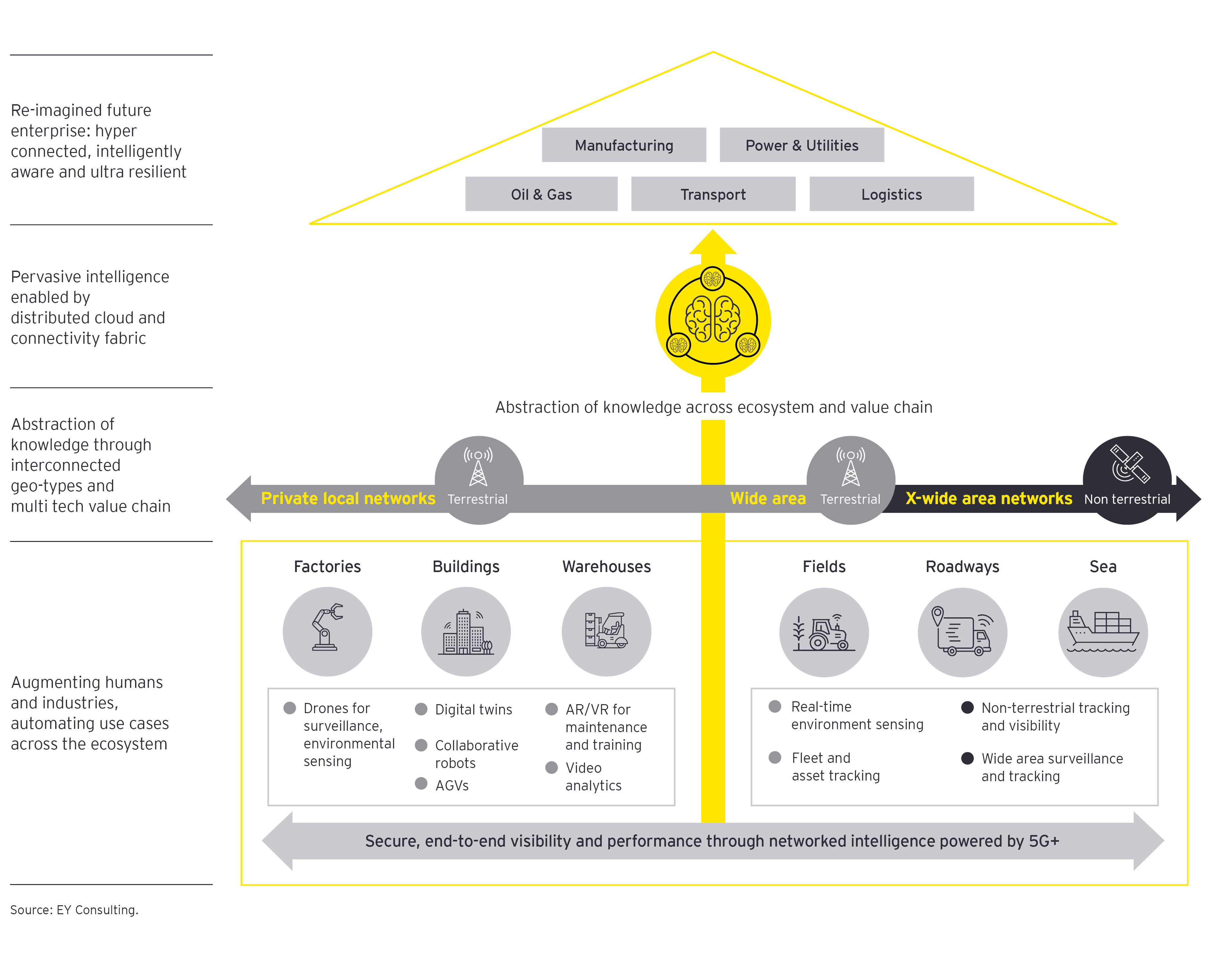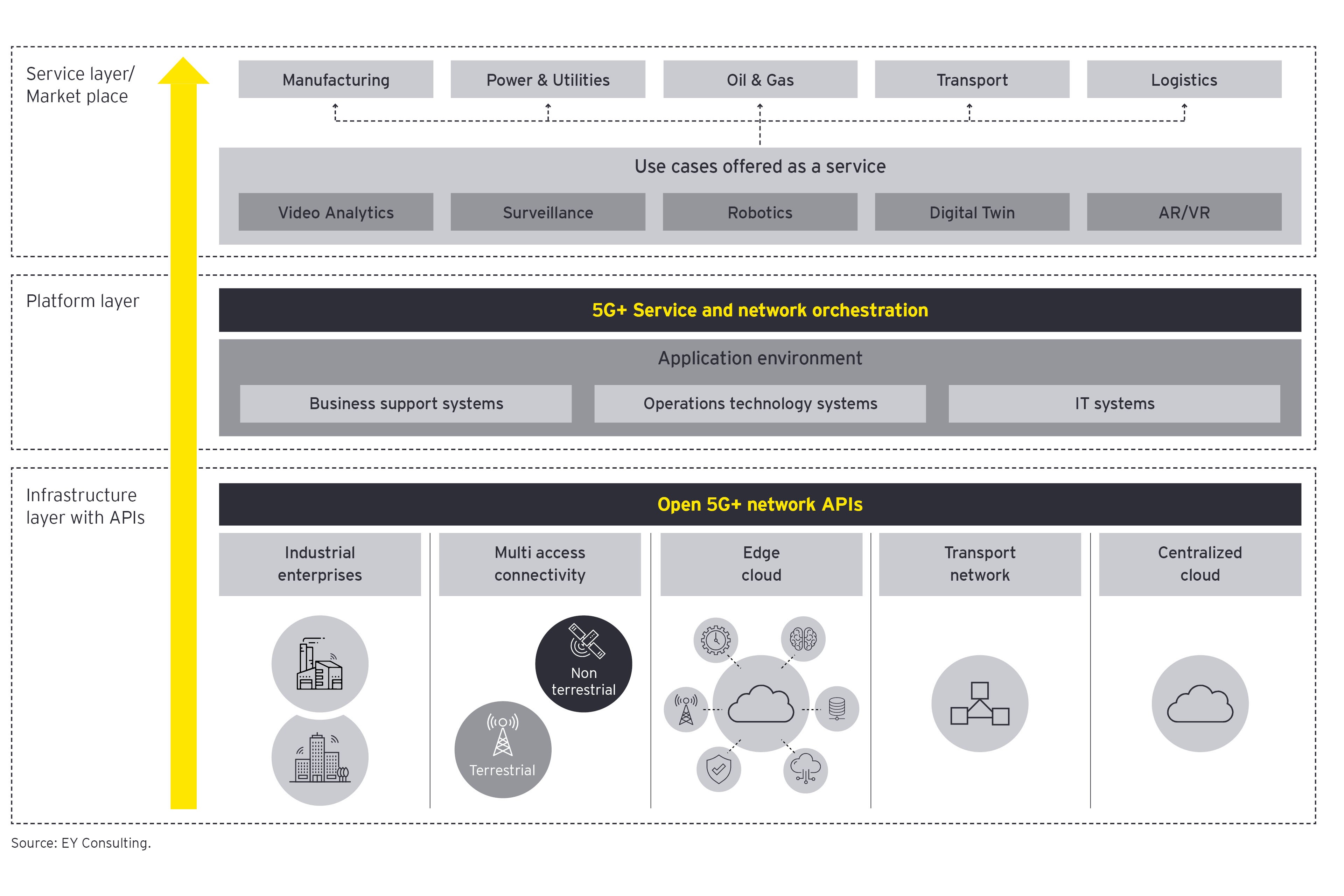
Chapter 1
What is pervasive intelligence?
Pervasive intelligence will power economies via networked ecosystems, breaking down silos to drive true sector convergence.
End-to-end pervasive intelligence will be possible via an ecosystem, stitched together across multiple, adjacent terrestrial and non-terrestrial networks. In supply chains, these integrated networks will form a seamless federation and exchange of intelligence between factories, warehouses in private local networks settings, and the land, rail and sea in wide and ultra-wide area networks.
The days of moving products and services through linear supply chains, from raw materials to delivery, will be replaced with fully networked ecosystems of hundreds of suppliers, carriers and companies working toward a common goal.
Reimagining the future of human-industrial operation

Digital twins will allow simultaneous localization and mapping of data to create perfect 3D models, providing insight into not just the physical characteristics of an object but its context, meaning and function. As a result, employees, enterprises and their ecosystem partners should be far more knowledgeable, productive and efficient. The human workforce will have access to new levels of real-time insight, augmenting their physical and cognitive capabilities.
Pervasive intelligence will power economies, globally and locally, breaking down silos to drive true sector convergence. It will offer itself as the foundation of Web 3.0, optimizing and scaling future metaverses, through high-performance, cloud-integrated networks that are decentralized in nature, ubiquitous, reliable and secure.

Chapter 2
An intelligent start: realizing the promise of 5G+
5G+ will democratize access to frontier capabilities and augment the reach, creativity, and impact of technology to industries and people.
To realize this vision, networking and computing capabilities such as distributed edge clouds, enterprise private networks, artificial intelligence (AI) and robotics must come together in a secure manner, offered as a platform that we call 5G+.
The idea will be to merge enterprise operations technology and industrial information and communications technology (ICT), and be consumed “as a service,” giving users access to tools and techniques from anywhere, at any time. This will democratize access to frontier capabilities and augment the reach, creativity and impact of technology to industries and people.
5G is the already-present enabler of this future reality, bringing not just a boost in connectivity but an architectural shift through which cloud computing becomes integrated into connectivity networks and moves to the edge.
The rise of open, disaggregated, cloud-based networks will usher innovation by giving industries complete visibility, helping them realize a new level of productivity only possible with intelligence that is pervasive across geo-types and adapted to varying service needs. It will fuel entrepreneurism, new business models and markets, and new winners.
For example, 5G+ is a layered architecture with the potential to enable a thriving enterprise application marketplace which makes it possible for companies to fully leverage the potential of 5G+ networks through open application programming interfaces (APIs). There will be new business models to catalyze 5G adoption across sectors, enable frictionless consumption of advanced services, and deliver measurable benefits across the value chain.
When physical, digital and human worlds collide in the era of pervasive intelligence, innovators will also create new analytical tools to ensure people can make use of, and not be overwhelmed by, the data rush.
Cloud integrated networks (5G+) layered architecture

We can already see signs of this future architecture in today’s most advanced manufacturing facilities. The World Economic Forum, Global Lighthouse Network 2022, notes that industry 4.0 pioneers are adopting the 5G+ vision, intertwining cyber and physical capabilities, and successfully raising output, while slashing energy and environmental impact. But hyper-visibility and automation will further improve efficiencies and productivity while reducing emissions.
At an economy-wide level, these rapid efficiency gains will improve the per-capita GVA-to-emissions ratio and pervasive intelligence will augment environmental, social and governance (ESG) performance. This will enable total visibility into environmental impact and provide real-time monitoring of climate change and its unpredictable effects.

Chapter 3
The road to pervasive intelligence
5G+ expansion requires breaking down barriers and cooperating across ecosystems to develop integrated infrastructures.
Reaching the era of pervasive intelligence requires interconnected and integrated infrastructure spanning local areas, campuses, and the wider geographies in which sectors and supply chains are situated. This is not currently the case and is limiting the realization of 5G+ and all its promise. Enterprises across the value chain need to mobilize, and governments need to work with industry to create the right frameworks for doing so.
Ecosystem enablement
Pervasive intelligence requires ecosystem federation and trusted data orchestration, with multiple partners and nodes, whether of devices or clouds, networked together. The EY 2021 CEO Imperative Study found data centricity and trust is paramount for future success, however only 34% of the respondents showed trust in their data and the role intelligent technologies can play to bridge that gap.
In pursuit of this objective, companies that harness external partnerships and ecosystems will generate significant value; according to the 2022 EY Ecosystem Study, 69% of business leaders from companies that are part of an ecosystem credit it as very important to their success.
Nine out of ten said ecosystems increase their resilience. According to the EY Reimagining Industry Futures (pdf) study, 73% of the executives want to prioritize suppliers who can provide relevant ecosystem relationships.
Ecosystems and partnerships matter because transformation to the pervasive intelligence era will occur in dynamic and live operating environments, requiring transition without a loss of capacity. This cannot be done smoothly if companies operate separately and in isolation.
EY Reimagining Industry Futures study
73%of executives surveyed want to prioritize suppliers who can provide relevant ecosystem relationships.
Cybersecurity and regulation
Cybersecurity provisions will be essential. Geo-specific industries like manufacturing, mining and warehousing have stringent requirements and fixed proprietary operations technology systems on multi-year licenses. These are contained and secure, but as ICT standards mature with 5G+, they will collide with legacy operational technology (OT) systems. The North Star is a high-performance, low-latency, ultra-secure network that is also multi-access. But short-term focus, risk perception could lead some firms to stick with outdated, fragmented, proprietary systems for fear of glitches.
Regulation and standardization will need to evolve. Just like algorithms and artificial intelligence have exposed the weaknesses and blind spots of ICT regulations, a network of networks will put pressure on the norms governing everything from privacy to antitrust; tax to trade protection. Efficient standards will be critical to allow interworking, compared to a currently fragmented environment across 5G, from terrestrial and satellites.
Here again, the ecosystem approach pays dividends to all participants. An EY ecosystem study found its benefits extend beyond the boundaries of organizations and can impact whole markets and value chains. Over 85% of executives agreed that ecosystems are an effective way to connect large companies with small disruptors and foster innovation across value chains and with adjacent industries.
A human-centric approach
Finally, transformation must be anchored in a human-centric approach. EY research with the University of Oxford Saïd Business School, has found that re-imagining alternate futures can bring varying emotions in the workforce during the transformation journey, ranging from hope, through to uncertainty and loss of confidence and anxiety, which can all stymie reforms.
Understanding and supporting teams by including leadership, collaboration, care, empowerment and inspiration as part of the transformation effort can increase the probability of success to more than 70%. Human centered technologies that augment and extend our capabilities to cope with and benefit from the creation of new knowledge will be critical as we prepare to enter the era of 6G and pervasive intelligence.

Chapter 4
Key actions for industry leaders
Preparing for pervasive intelligence will require vision and sophisticated orchestration, we outline the steps to take now.
The vision of pervasive intelligence is sector-agnostic but ecosystem-dependent. How we design, orchestrate and deploy the 5G+ technology stack and disrupt business models will be essential in future vision. It will take time to develop, requiring new forms of collaboration and community. It will unfold unevenly, led by frontier sectors that stand to benefit the most. Having a bold vision of this future will help companies streamline investments today and chart a transformation roadmap for tomorrow. The road to pervasive intelligence requires end-to-end approach for industries to prepare, position and benefit from this emerging future.
By leveraging these essential elements, companies can chart and execute a series of initiatives to transform their operations. To facilitate this transformation journey, companies should undertake a phased approach, addressing ideation, strategic planning and implementation.
Executing the transformation journey – from ideation to implementation
Ideation |
Strategic Planning |
Implementation |
|
|
|
Conclusion
Businesses are starting to evaluate the opportunities presented by the 5G+ digital fabric. This presents an architectural shift that integrates distributed cloud and multi-access networks to enable a connected edge economy with new applications and services.
This is just the foundational beginning for the emerging era of pervasive intelligence, which presents a ubiquitous, ecosystem-driven capability that improves productivity and efficiency. It will raise growth and reduce environmental impact to achieve global optimizations at scale.
To seize the opportunities of pervasive intelligence, firms need to act decisively now. A partnership, ecosystem-driven approach can help them explore the full range of collaborative potential and a human-centered, managed transformation program will ensure companies meet their productivity, resilience, safety and sustainability goals.
Deepak Winston, Director, Digital and Emerging Technology, EY Consulting, Ernst & Young LLP, contributed to this article.
Related articles
Summary
In the future, pervasive intelligence will radically augment the capabilities of companies and people, boosting productivity, efficiency and sustainability. To harness the power of pervasive intelligence, companies need to act now to create the right business models and use cases, while working with ecosystem partners to build the right tech architectures to facilitate it. These efforts to utilize pervasive intelligence present a multi-year journey, where companies must put people at the center of their transformations, as both co-creators and beneficiaries.

